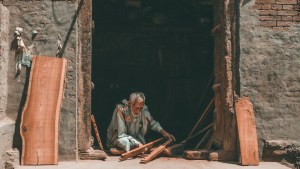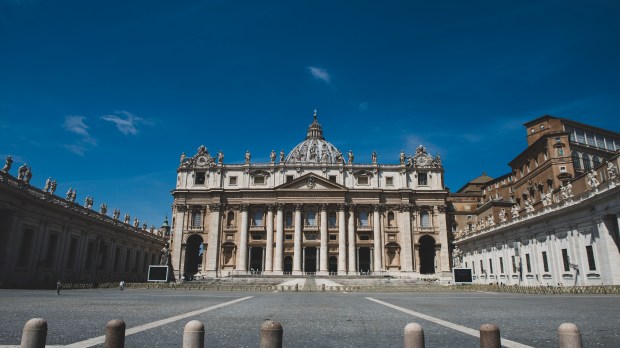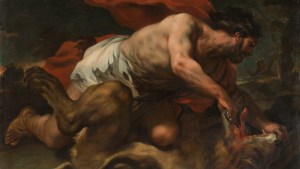It is rather hard to say where the word “Vatican” originally came from. Sure, it is the name of one of Rome’s seven hills, all located on the east margin of the river Tiber, within the city walls. But there are several different beliefs regarding how the Colle Vaticano — literally, the “Vatican Hill” — got its name.
As early as in the first century, the noted Roman rhetorician and philosopher Marcus Terentius Varro claimed the word derived from a local tutelar deity that was believed to provide infants with the capacity to speak. The deity, named “Vaticanus,” would “preside over the principles of the human voice; for infants, as soon as they are born, make the sound which forms the first syllable in Vaticanus, and are therefore said vagire (to cry) which word expresses the noise which an infant first makes.” St. Augustine, familiar as he was with Varro’s work, indeed mentions this deity three times in his City of God, and explicitly refers to this widespread Roman belief. (Cf. Augustine, City of God, 4, 8). However, it is more likely the word derives from the name of an ancient Etruscan settlement, possibly called Vatica or Vaticum. But no trace of it has been discovered.

The Vatican was not always the residence of the pope. In fact, until the mid-19th century popes lived mostly in the Lateran Palace, at the other side of the city. But this historical fact has not kept popular imagination from ascribing to the Vatican all kinds of stories related with papal myths and “secrets” — most of them easy to bust and debunk. Here are three brief examples.
1. The Vatican Archives
The Vatican Archives are far from being an amusement park for conspiracy theorists. In fact, most people would find them quite boring. The “mysterious” aura built around the Archivum Secretum Apostolicum Vaticanum — that is its official full name — might only be due to a mistranslation from the original Latin:secretum simply means “set apart,” as in “for personal use.” If you’ve ever had a secretaire (a secretary desk, an escritoire), you’ll have some notion of what this means: the Vatican “Secret Archive” is but a collection of personal documents, mainly private letters, chronicles and historical records of past popes.
In any case, this doesn’t make the Vatican Archive necessarily boring. Some scholars might consider it their own private Garden of Eden. In its shelves, the papal bull excommunicating Martin Luther can be found next to the complete 60-meter-long scroll with the minutes of the trials of the Knights Templar, letters from Michelangelo to Pope Julius II, the notes on the trial against Galileo, and even a letter from Pope Clement XII to the seventh Dalai Lama requesting protection for Franciscan friars in Tibet.
2. The “Secret Passage”
There is a corridor embedded in the only medieval wall of Rome that is left. It connects the Vatican Apostolic Palace to Castel Sant’Angelo.
The “last escape route of the popes,” is a 13th-century underground passage. It has captured the imagination of many writers. Dan Brown’s visit to that corridor gave him the idea to write his bestselling novel Angels and Demons — a fanciful work of fiction that portrays the Vatican as the stage for all kinds of conspiracies.
Brown claims the passage is about 400 meters long and reaches the pope’s private library. But in reality, it is twice as long. It ends near the papal residence, above the current headquarters of the Vatican couriers.
Although many like to think of this passage as the site of “escapades,” the corridor has only been used in strict emergencies. For instance, Alexander VI (the infamous Borgia Pope) used it in 1494 to take refuge in Castel Sant’Angelo when the French troops of King Charles VIII invaded Rome. It was also used on May 6, 1527, when the Protestant factions of Charles V sacked Rome. On that day 147 Swiss guards died trying to protect Peter’s tomb, while another 42 protected Pope Clement VII who, crossing the emergency passage, took refuge in the castle.
3. The Vatican Library
The Vatican Apostolic Library was officially established in 1475, although it is actually much older. Historians explain the Vatican Apostolic Library has its origins in the earliest days of Christianity. In fact, some manuscripts from the first centuries of Christianity are (naturally) preserved here. Established in the Lateran Palace until the late 13th century, it grew exponentially during the papacy of Boniface VIII, who owned one of the biggest collections of illuminated manuscripts in Europe. However, it was only in 1451 when Pope Nicholas V, a renowned bibliophile himself, attempted to re-establish Rome as an academic center of global importance, building a relatively modest library of over 1,200 volumes, including his personal collection of Greek and Roman classics and a series of texts brought from Constantinople.
Nowadays, the Vatican Library treasures include around 75,000 codices and 85,000 incunabula (i.e., editions made between the invention of the printing press and the 16th century), for a grand total of more than a million books. Far from being secret, all these treasures are online.You can search the library and download its archives just by clicking here.



